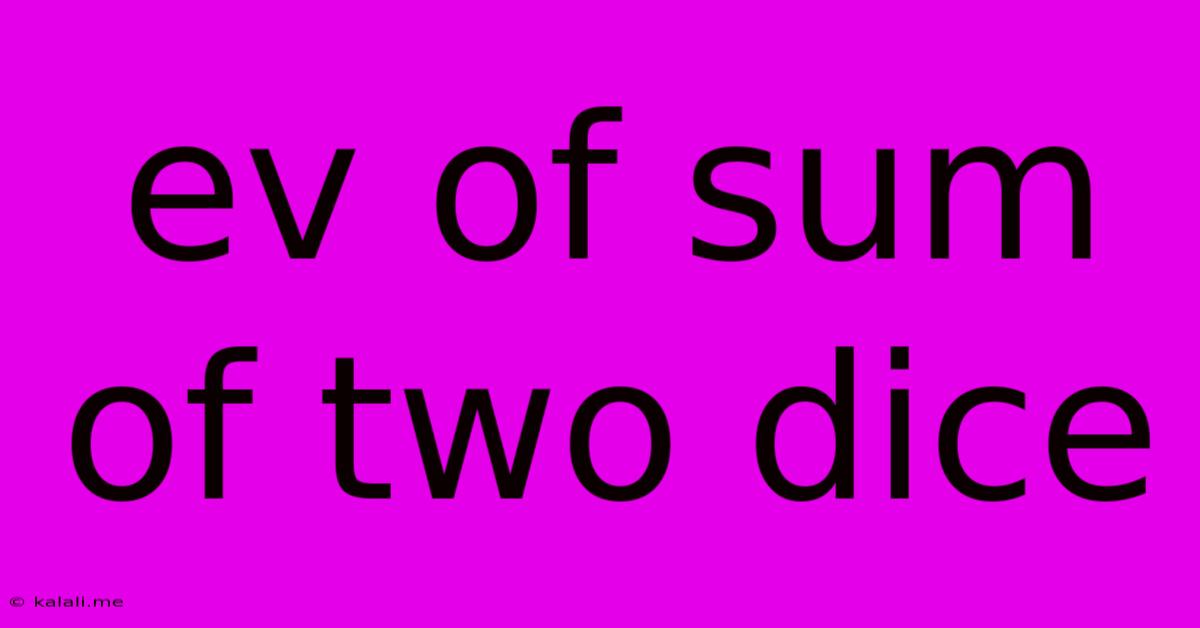Ev Of Sum Of Two Dice
Kalali
May 30, 2025 · 3 min read

Table of Contents
The Expected Value of the Sum of Two Dice: A Comprehensive Guide
This article explores the concept of expected value (EV) in the context of rolling two fair six-sided dice. We'll delve into calculating the EV, understanding its implications, and examining related probability concepts. Understanding expected value is crucial in various fields, from gambling to financial modeling, and this simple dice example provides a clear and accessible introduction.
What is Expected Value?
Expected value, or expectation, represents the average outcome of a random variable over many trials. It's a weighted average, where each possible outcome is weighted by its probability. In simpler terms, it's what you'd expect the average result to be if you repeated the experiment many times.
Calculating the EV of the Sum of Two Dice
To calculate the expected value of the sum of two dice, we need to consider all possible outcomes and their probabilities. Each die has six sides (1, 2, 3, 4, 5, 6), so there are 36 possible outcomes when rolling two dice (6 x 6).
Here's a step-by-step approach:
-
List all possible outcomes and their sums: Create a table showing all possible combinations of the two dice and their corresponding sums.
-
Calculate the probability of each sum: Determine the probability of each sum occurring. For example, a sum of 7 can be achieved in six ways (1+6, 2+5, 3+4, 4+3, 5+2, 6+1), so its probability is 6/36 = 1/6.
-
Multiply each sum by its probability: Multiply each possible sum by its probability.
-
Sum the results: Add up all the products from step 3. This sum represents the expected value.
Let's illustrate this with a table:
| Sum | Possible Combinations | Number of Combinations | Probability | Sum * Probability |
|---|---|---|---|---|
| 2 | (1,1) | 1 | 1/36 | 2/36 |
| 3 | (1,2), (2,1) | 2 | 2/36 | 6/36 |
| 4 | (1,3), (2,2), (3,1) | 3 | 3/36 | 12/36 |
| 5 | (1,4), (2,3), (3,2), (4,1) | 4 | 4/36 | 20/36 |
| 6 | (1,5), (2,4), (3,3), (4,2), (5,1) | 5 | 5/36 | 30/36 |
| 7 | (1,6), (2,5), (3,4), (4,3), (5,2), (6,1) | 6 | 6/36 | 42/36 |
| 8 | (2,6), (3,5), (4,4), (5,3), (6,2) | 5 | 5/36 | 40/36 |
| 9 | (3,6), (4,5), (5,4), (6,3) | 4 | 4/36 | 36/36 |
| 10 | (4,6), (5,5), (6,4) | 3 | 3/36 | 30/36 |
| 11 | (5,6), (6,5) | 2 | 2/36 | 22/36 |
| 12 | (6,6) | 1 | 1/36 | 12/36 |
| Total | 252/36 = 7 |
Therefore, the expected value of the sum of two dice is 7.
Implications and Further Considerations
This result demonstrates that, on average, you would expect the sum of two dice to be 7 over many rolls. This is a fundamental concept in probability and statistics, with applications in various fields like game theory and risk assessment. Further exploration could involve calculating the expected value of other dice games or exploring variations using weighted or biased dice. Understanding variance and standard deviation alongside expected value provides a more complete picture of the distribution of possible outcomes.
Latest Posts
Latest Posts
-
How Heavy Is 50 Feet Of Rope
May 31, 2025
-
Google Sheet Print Selection As Csv
May 31, 2025
-
Chopin Waltz In C Sharp Minor
May 31, 2025
-
What Flew Over Charlotte Nc Last Night
May 31, 2025
-
Java Home Should Point To A Jdk Not A Jre
May 31, 2025
Related Post
Thank you for visiting our website which covers about Ev Of Sum Of Two Dice . We hope the information provided has been useful to you. Feel free to contact us if you have any questions or need further assistance. See you next time and don't miss to bookmark.